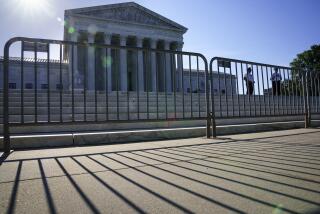LAW / THE CONSTITUTION : Overruling High Court Usually a Futile Effort : Just four amendments reversing justices’ rulings have survived difficult process and been adopted.
- Share via
WASHINGTON — In calling for a constitutional amendment to overturn Monday’s Supreme Court flag-burning decision, President Bush and his supporters have joined a long, and almost entirely unsuccessful, line.
In the 200 years since the Constitution was adopted, political leaders have tried to reverse high court decisions on everything from income taxes--in which they succeeded--to school busing--in which repeated attempts failed. Only four such amendments ever have been adopted.
Efforts by politicians to overturn high-court decisions usually fail because the writers of the Constitution planned it that way, setting up a long, difficult path that amendments must traverse: a two-thirds vote in each house of Congress plus approval by three-quarters of the states. Usually, no matter how much a high court decision upsets people, passions cool by the time the amendment process is half over, and efforts to change the Constitution run out of steam.
In at least one case, time changed the court itself. In 1918, the high court ruled that Congress did not have the power to forbid child labor. Congress approved a constitutional amendment in 1924, but the proposal languished in the state legislatures. Then, in 1941, the high court abandoned its earlier rulings, upholding a child labor law.
During the activist tenure of the late Chief Justice Earl Warren in the 1950s and 1960s, conservatives tried repeatedly to gain approval of amendments overturning court decisions that limited school prayer and expanded voting rights and school busing. But the only successful amendment in that period was the one giving 18-year-olds the right to vote. That amendment was approved in record time in 1971. It reversed a high court ruling that Congress could not tell states what voting age to use.
By contrast, other attempts to overturn court rulings took decades. In 1895, the court ruled that the Constitution did not allow a federal income tax. The drive to reverse that decision took 18 years, finally succeeding in 1913.
The most important attempt to overturn a court decision required not only time, but a war, to succeed.
In 1857, in the notorious Dred Scott case, the court ruled that the protections of national citizenship did not apply to blacks. After the Civil War, the 14th Amendment reversed Dred Scott, guaranteeing full citizenship to all persons born or naturalized in the United States. Congress guaranteed ratification by requiring Southern states to approve the amendment before they could be readmitted to the Union.
The first time an amendment overturned the high court was in 1792, when a resident of South Carolina went to federal court to force the state of Georgia to return a parcel of confiscated property. The state argued that it could be sued only in its own courts, not in federal court. When the Supreme Court disagreed, outraged state governments insisted on a constitutional amendment--the 11th--which was ratified the next year.
More to Read
Get the L.A. Times Politics newsletter
Deeply reported insights into legislation, politics and policy from Sacramento, Washington and beyond. In your inbox twice per week.
You may occasionally receive promotional content from the Los Angeles Times.











